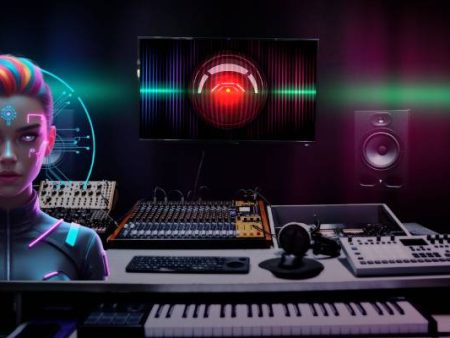I remember the first time I heard an AI-generated composition modeled after Mozart. It was a live performance, a string quartet playing notes that, on the surface, could’ve come straight out of 18th-century Vienna.
The audience clapped, politely but cautiously. The music was beautiful, yes. Yet something about it felt… different. Not worse, not better—just strange.
And that’s where we stand today. Caught in a curious moment where centuries-old masterpieces collide with modern algorithms.
The question isn’t just whether AI can recreate Mozart, Bach, or Beethoven. It’s whether these digital echoes can stir the same emotions those human geniuses conjured.
So let’s walk through this together. Let’s explore how AI is reimagining classical compositions, where it falls short, where it shines, and what it means for the future of songwriting: in a world that refuses to sit still.
A Quick Journey: From Quills to Quantum Chips
Mozart wrote by candlelight. Bach composed within the constraints of church commissions.
Beethoven scribbled in sketchbooks while fighting deafness. Each note bore not just structure but also sweat, stubbornness, and soul.
Fast forward a few centuries, and we’re in a world where AI models like Aiva, OpenAI’s Jukebox, and Google’s Magenta don’t need candles or commissions.
They need data—massive datasets of classical works, analyzed and recombined into “new” compositions.
It’s a shift so radical that some critics worry: does a symphony still matter if it’s generated by code? And others, more optimistic, argue: isn’t this just the next chapter in music’s long history of evolution?
AI in the Studio: Redefining the Composer’s Tools
It’s not only theoretical anymore. Musicians are already using AI in the studio: to assist with orchestration, fill out arrangements, and even generate drafts of entire movements.
Think of it this way: composers once relied on apprentices to transcribe and expand their ideas. Now, AI can serve as a kind of digital apprentice.
It won’t complain, it won’t tire, and it can spin out dozens of variations before your coffee even cools.
And that’s where my opinion comes in. I don’t see AI as replacing composers. I see it as a collaborator, albeit a weird one.
A collaborator without ego, without life experience, but with endless patience and memory.
Can AI Really Capture Emotion in Classical Music?
This is where things get thorny. Classical music isn’t just about precision—it’s about passion. When a string quartet lingers on a phrase or a pianist hesitates just before striking a note, that’s humanity bleeding into the sound.
AI-generated compositions, for all their technical brilliance, often lack this depth. They can mirror harmonic structures, replicate counterpoint, and even surprise us with unexpected modulations.
But the big question—can a machine evoke the same goosebumps as Beethoven’s Ninth?—remains unanswered.
A 2023 MIT study found that listeners misattributed 40% of AI-generated classical pieces as human-composed. That suggests machines are getting better at imitation.
But as I listened to one such piece myself, I found it intellectually impressive and emotionally thin. It was like eating a beautifully decorated cake that tasted faintly of cardboard.
Why Classical Music and AI Are a Fascinating Match
Despite these challenges, classical music is uniquely suited for AI experiments. Why?
- Data-rich: There are centuries of scores available to train on.
- Structured: Classical compositions follow formal patterns (sonata form, fugues, rondos), which algorithms love.
- Timeless appeal: Unlike pop, classical pieces don’t rely on lyrics tied to cultural moments. The music itself is the story.
This makes classical music both a playground and a proving ground for AI systems. If algorithms can master Mozart, maybe they can handle jazz, rock, or film scoring too.
Step-by-Step Guide: How to Experiment With AI Classical Tools
Curious about trying it yourself? Here’s a step-by-step guide: how to explore AI-generated classical compositions:
- Choose a Platform
- Aiva (focused on orchestral/classical styles).
- Magenta Studio (open-source experiments).
- OpenAI Jukebox (raw audio generation, more experimental).
- Start With a Style
- Input “in the style of Mozart” or “string quartet in D minor.” Most tools allow stylistic prompts.
- Listen Without Judgment (At First)
- Resist the urge to dismiss it right away. Ask yourself: does it sound convincing? Where does it succeed, where does it falter?
- Customize
- Many platforms let you tweak tempo, instrumentation, or harmony. This is where human input really matters.
- Record Your Own Layer
- Play or sing over the generated track. See how blending human imperfection with machine precision feels.
- Reflect
- Did the process inspire you, frustrate you, or leave you cold? Your emotional reaction is as important as the output itself.
Top Free AI Music Platforms for Classical Experimentation
If you want to dip your toes without spending money, here are some top free ai music options:
- Aiva (free tier): Limited but excellent for classical scoring.
- Magenta Studio: Google’s open-source project with plugins for Ableton Live.
- Boomy: More pop-oriented, but surprisingly flexible for experimentation.
- Ecrett Music: Simplified interface, accessible for beginners.
These tools won’t give you a Carnegie Hall-ready composition, but they’ll let you explore the frontier without breaking your budget.
The Future of Songwriting: Classical Meets Code
So, what’s next? For me, the future of songwriting: in classical music isn’t about AI overtaking Beethoven.
It’s about a fusion. Imagine a conservatory student in 2030 composing a string quartet not just with a pen and staff paper, but with an AI partner suggesting counterpoint in real time.
Orchestras might perform “collaborative” works credited to both human and machine. And audiences—at first skeptical—may eventually accept that a piece’s worth lies not in who wrote it, but in how it moves us.
But here’s the cautionary note. If AI compositions flood streaming platforms and background playlists, classical music risks being cheapened, stripped of its intimacy.
The challenge will be curating quality and preserving the emotional depth that has always defined the genre.
A Personal Reflection: Between Reverence and Resistance
I’ll admit something. I admire the precision of AI-generated fugues. I’ve even enjoyed a few enough to put them on while working.
But when I sit in a concert hall, waiting for a human pianist to wrestle with a Chopin nocturne, I know I’m waiting for something algorithms can’t give me: fragility.
Music isn’t only about notes. It’s about stories lived and shared. Machines can echo the notes, but not the living. And that’s where my heart still draws the line.
Conclusion: From Awe to Awareness
So, can AI reimagine classical compositions? Absolutely. Can it rival Mozart? In structure, yes. In spirit, not yet.
This is not a lament, though. It’s a recognition that technology, once again, is expanding our definition of music.
We’re entering a world where collaboration with machines could open new frontiers, even as we cling to the raw humanity that keeps music sacred.
In the end, whether AI-generated or human-written, a composition’s true test remains the same: did it make us feel something?
If the answer is yes, maybe we shouldn’t be so quick to draw lines between quill and quantum chip.


